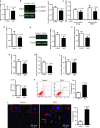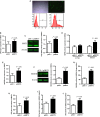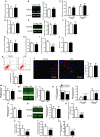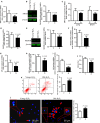Decreased SIRT3 in aged human mesenchymal stromal/stem cells increases cellular susceptibility to oxidative stress
- PMID: 25210848
- PMCID: PMC4224562
- DOI: 10.1111/jcmm.12395
Decreased SIRT3 in aged human mesenchymal stromal/stem cells increases cellular susceptibility to oxidative stress
Abstract
Sirtuin3 (SIRT3) is an important member of the sirtuin family of protein deacetylases that is localized to mitochondria and linked to lifespan extension in organisms ranging from yeast to humans. As aged cells have less regenerative capacity and are more susceptible to oxidative stress, we investigated the effect of ageing on SIRT3 levels and its correlation with antioxidant enzyme activities. Here, we show that severe oxidative stress reduces SIRT3 levels in young human mesenchymal stromal/stem cells (hMSCs). Overexpression of SIRT3 improved hMSCs resistance to the detrimental effects of oxidative stress. By activating manganese superoxide dismutase (MnSOD) and catalase (CAT), SIRT3 protects hMSCs from apoptosis under stress. SIRT3 expression, levels of MnSOD and CAT, as well as cell survival showed little difference in old versus young hMSCs under normal growth conditions, whereas older cells had a significantly reduced capacity to withstand oxidative stress compared to their younger counterparts. Expression of the short 28 kD SIRT3 isoform was higher, while the long 44 kD isoform expression was lower in young myocardial tissues compared with older ones. These results suggest that the active short isoform of SIRT3 protects hMSCs from oxidative injury by increasing the expression and activity of antioxidant enzymes. The expression of this short isoform decreases in cardiac tissue during ageing, leading to a reduced capacity for the heart to withstand oxidative stress.
Keywords: SIRT3; ageing; antioxidants; mesenchymal stromal/stem cells; myocardium; oxidative stress.
© 2014 The Authors. Journal of Cellular and Molecular Medicine published by John Wiley & Sons Ltd and Foundation for Cellular and Molecular Medicine.
Figures





Similar articles
-
Sirtuin3 protects aged human mesenchymal stem cells against oxidative stress and enhances efficacy of cell therapy for ischaemic heart diseases.J Cell Mol Med. 2018 Nov;22(11):5504-5517. doi: 10.1111/jcmm.13821. Epub 2018 Aug 9. J Cell Mol Med. 2018. PMID: 30091830 Free PMC article.
-
SIRT3 Transfection of Aged Human Bone Marrow-Derived Mesenchymal Stem Cells Improves Cell Therapy-Mediated Myocardial Repair.Rejuvenation Res. 2020 Dec;23(6):453-464. doi: 10.1089/rej.2019.2260. Epub 2020 Apr 28. Rejuvenation Res. 2020. PMID: 32228121
-
Sirtuin 3 regulates Foxo3a-mediated antioxidant pathway in microglia.Neuroscience. 2015 Dec 17;311:398-414. doi: 10.1016/j.neuroscience.2015.10.048. Epub 2015 Oct 30. Neuroscience. 2015. PMID: 26523980
-
Regulation of MnSOD enzymatic activity by Sirt3 connects the mitochondrial acetylome signaling networks to aging and carcinogenesis.Antioxid Redox Signal. 2014 Apr 1;20(10):1646-54. doi: 10.1089/ars.2013.5482. Epub 2013 Sep 14. Antioxid Redox Signal. 2014. PMID: 23886445 Free PMC article. Review.
-
Regulation of SIRT3 on mitochondrial functions and oxidative stress in Parkinson's disease.Biomed Pharmacother. 2020 Dec;132:110928. doi: 10.1016/j.biopha.2020.110928. Epub 2020 Oct 28. Biomed Pharmacother. 2020. PMID: 33128944 Review.
Cited by
-
Sirtuins and Their Roles in Brain Aging and Neurodegenerative Disorders.Neurochem Res. 2017 Mar;42(3):876-890. doi: 10.1007/s11064-016-2110-y. Epub 2016 Nov 24. Neurochem Res. 2017. PMID: 27882448 Free PMC article. Review.
-
SIRT3 protects endometrial receptivity in patients with polycystic ovary syndrome.Chin Med J (Engl). 2025 May 20;138(10):1225-1235. doi: 10.1097/CM9.0000000000003127. Epub 2024 May 9. Chin Med J (Engl). 2025. PMID: 38721809 Free PMC article.
-
Opportunities and Challenges in Stem Cell Aging.Adv Exp Med Biol. 2021;1341:143-175. doi: 10.1007/5584_2021_624. Adv Exp Med Biol. 2021. PMID: 33748933 Review.
-
Role of SIRT3 in bone homeostasis and its application in preventing and treating bone diseases.Front Pharmacol. 2023 Dec 20;14:1248507. doi: 10.3389/fphar.2023.1248507. eCollection 2023. Front Pharmacol. 2023. PMID: 38192409 Free PMC article. Review.
-
Antioxidant treatment enhances human mesenchymal stem cell anti-stress ability and therapeutic efficacy in an acute liver failure model.Sci Rep. 2015 Jun 9;5:11100. doi: 10.1038/srep11100. Sci Rep. 2015. PMID: 26057841 Free PMC article.
References
-
- Zhang H, Fazel S, Tian H, et al. Increasing donor age adversely impacts beneficial effects of bone marrow but not smooth muscle myocardial cell therapy. Am J of Physiol-Heart Circulatory Physiol. 2005;289:H2089–96. - PubMed
-
- Fan M, Chen W, Liu W, et al. The effect of age on the efficacy of human mesenchymal stem cell transplantation after a myocardial infarction. Rejuvenation Res. 2010;13:429–38. - PubMed
-
- Murdoch CE, Zhang M, Cave AC, et al. NADPH oxidase-dependent redox signalling in cardiac hypertrophy, remodelling and failure. Cardiovasc Res. 2006;71:208–15. - PubMed
Publication types
MeSH terms
Substances
LinkOut - more resources
Full Text Sources
Other Literature Sources
Molecular Biology Databases
Research Materials
Miscellaneous

